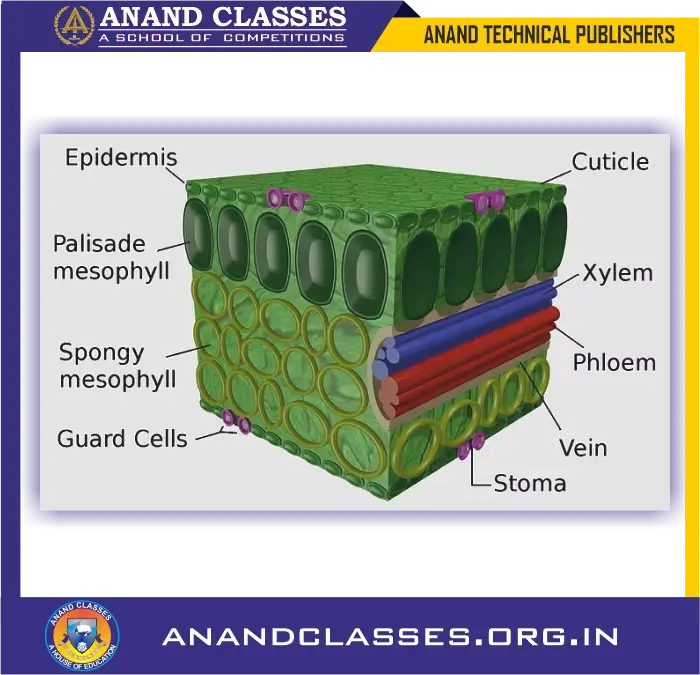ANAND CLASSES Study Material and Notes to learn about chloroplasts, the site of photosynthesis, their structure and function, and their role in food production in plants. Ideal for Class 10 Science Biology and NEET Foundation preparation.
Site of Photosynthesis: Chloroplasts
Photosynthesis is the fundamental process by which plants convert light energy into chemical energy. The primary site of photosynthesis in plants is the chloroplasts, which are specialized organelles found in the cells of green plants, particularly in mesophyll cells of leaves.
Structure and Function of Chloroplasts
Chloroplasts are essential organelles in plant cells that facilitate photosynthesis. They possess a unique structure that enables them to efficiently capture light energy and convert it into chemical energy.

- 🌿 Chloroplasts: The Site of Photosynthesis
- Tiny green organelles in plant cells containing chlorophyll.
- Photosynthesis occurs in chloroplasts of mesophyll cells in green plants.
- Easily visible under a light microscope.
- 🍃 Location of Chloroplasts in Leaves
- Found in mesophyll cells of the palisade tissue, just below the upper epidermis.
- Present in the palisade and spongy layers of the leaf.
- These cells contain higher chlorophyll content than other plant cells.
- 🔬 Structure of Mesophyll Cells & Chloroplasts
- A single mesophyll cell may house 100+ chloroplasts.
- A whole leaf contains thousands of photosynthetic cells.
- 💨 Gas & Water Exchange for Photosynthesis
- 🌬️ CO2 Entry: Enters through stomata, diffuses into mesophyll cells, and reaches chloroplasts.
- 💧 Water Supply: Transported by xylem vessels, moves into mesophyll cells, and reaches chloroplasts.
- 🛡️ Protection Against Water Loss
- A thin, waxy cuticle covers both sides of the leaf.
- Helps in reducing water loss and maintaining moisture balance.

Important Questions With Answers
Q1: What is the site of photosynthesis in green plants?
A: The site of photosynthesis in green plants is the chloroplasts, present in the mesophyll cells of the leaf.
Q2: How does carbon dioxide enter the leaf for photosynthesis?
A: Carbon dioxide enters the leaf through stomata, then diffuses into mesophyll cells and reaches chloroplasts.
Q3: Why do mesophyll cells have more chlorophyll than other cells?
A: Mesophyll cells have more chlorophyll to efficiently capture light energy required for photosynthesis.
FAQs (Frequently Asked Questions)
Q1: Can photosynthesis occur without chloroplasts?
A: No, photosynthesis cannot occur without chloroplasts as they contain chlorophyll necessary to capture light energy.
Q2: Why are chloroplasts green?
A: Chloroplasts appear green because they contain chlorophyll, which absorbs light in the blue and red wavelengths and reflects green light.
Q3: Where are most chloroplasts found in a leaf?
A: Most chloroplasts are found in palisade mesophyll cells, as they are closest to the upper surface of the leaf where maximum light is available.
Conceptual Questions with Answers
Q1: How does the structure of a leaf support photosynthesis?
A: The structure of a leaf supports photosynthesis in the following ways:
- Broad and flat shape – Increases the surface area for light absorption.
- Thin structure – Reduces the diffusion distance for gases.
- Presence of stomata – Facilitates gas exchange.
- Vascular bundles (xylem & phloem) – Transport water and nutrients efficiently.
Q2: What would happen if chloroplasts were absent in a plant cell?
A: Without chloroplasts, a plant would be unable to conduct photosynthesis, leading to a lack of energy production and eventual death.
Multiple Choice Questions (MCQs) with Explanations
Q1: Which organelle is responsible for photosynthesis in plants?
A) Mitochondria
B) Ribosomes
C) Chloroplasts
D) Nucleus
Answer: C) Chloroplasts
Explanation: Photosynthesis occurs in chloroplasts, which contain chlorophyll essential for capturing light energy.
Q2: What is the function of stomata in photosynthesis?
A) Absorbing water
B) Transporting sugars
C) Allowing gas exchange
D) Storing chlorophyll
Answer: C) Allowing gas exchange
Explanation: Stomata open and close to regulate the entry of carbon dioxide and the release of oxygen during photosynthesis.
Do You Know?
- A single mesophyll cell contains 100 or more chloroplasts.
- Chloroplasts have their own DNA and ribosomes, allowing them to self-replicate.
- The palisade layer contains the most chloroplasts in a leaf, making it the primary site of photosynthesis.
Worksheet
- Define photosynthesis and state its importance.
- Draw and label the structure of a chloroplast.
- Explain the role of chlorophyll in photosynthesis.
- Differentiate between palisade mesophyll and spongy mesophyll.
- Describe the function of stomata in photosynthesis.
Test Paper (Total Marks: 10)
Section A: Short Answer Questions (2 Marks Each)
- What is the primary site of photosynthesis in plant cells?
- How does carbon dioxide reach the chloroplasts for photosynthesis?
- Why do chloroplasts appear green in color?
Section B: Diagram-Based Question (4 Marks)
- Draw and label a cross-section of a leaf showing mesophyll cells and chloroplasts.
Section C: Application-Based Question (2 Marks)
- What would happen to a plant kept in complete darkness for a week? Explain.
Important Points for Quick Revision
- Chloroplasts are the sites of photosynthesis in mesophyll cells.
- Chlorophyll absorbs light energy and converts it into chemical energy.
- Carbon dioxide enters the leaf through stomata.
- Water reaches the chloroplasts via xylem.
- Leaves have a broad surface area to absorb maximum light.
- Cuticle prevents excessive water loss while allowing light penetration.


